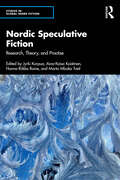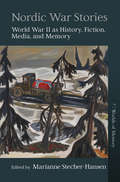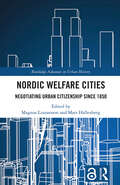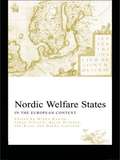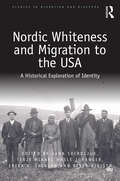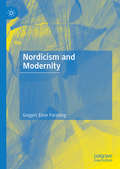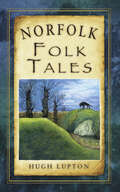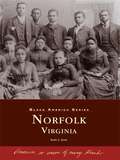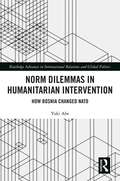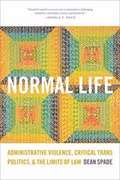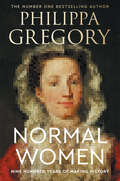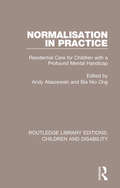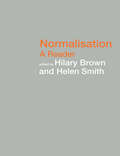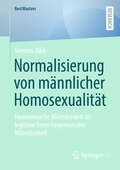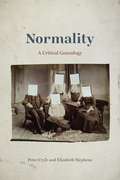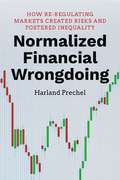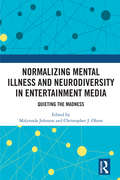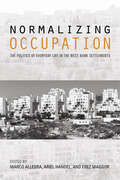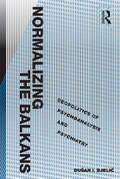- Table View
- List View
Nordic Speculative Fiction: Research, Theory, and Practise (Studies in Global Genre Fiction)
by Jyrki Korpua, Aino-Kaisa Koistinen, Hanna-Riikka Roine, and Marta Mboka TveitThis volume brings together scholarly theories and practices on speculative fiction from the Nordic countries, including Denmark, Finland, Iceland, Norway, and Sweden, that are all rooted in similar values, culture, and history yet are independent and unique societies. The book exhibits both the convergences and the diversity of the Nordics in fiction and fandom as well as in research.It traces the roots of Nordic speculative fiction, how it has developed over time, and how the changes in Nordic environments and societies caused by overhanging shared global issues – such as climate change, mass migration, and technological acceleration – find space in speculative practices. The first of its kind, this book allows for deeper insights into the unique characteristics that make Nordic literature and art recognisable and allows for a better understanding of the place of the Nordics within wider global culture systems. The chapters range from literary critiques, film and television studies, creative works by three Nordic creative writers, transcultural text comparisons, and contributions on speculative art to theoretical and methodological discussions on fandom, worldbuilding, and semantics.Part of the Studies in Global Genre Fiction series, this book contributes to connecting Nordic speculative fiction scholarship to the wider global community within the field. It will be of interest to scholars and general enthusiasts of speculative fiction and those with interest in Nordic fiction; film and television studies; literary, culture, or media studies; comparative literature; and cultural history or art-based research.
Nordic War Stories: World War II as History, Fiction, Media, and Memory (Worlds of Memory #7)
by Marianne Stecher-HansenSituated on Europe’s northern periphery, Denmark, Finland, Iceland, Norway, and Sweden found themselves caught between warring powers during World War II. Ultimately, these nations survived the conflict as sovereign states whose wartime experiences have profoundly shaped their historiography, literature, cinema and memory cultures. Nordic War Stories explores the commonalities and divergences among the five Nordic countries, examining national historiographies alongside representations of the war years in canonical literary works, travel writing, and film media. Together, they comprise a valuable companion that challenges the myth of Scandinavian homogeneity while demonstrating the powerful influence that the war continues to exert on national identities.
Nordic War Stories: World War II as History, Fiction, Media, and Memory (Worlds of Memory #7)
by Marianne Stecher-HansenSituated on Europe’s northern periphery, Denmark, Finland, Iceland, Norway, and Sweden found themselves caught between warring powers during World War II. Ultimately, these nations survived the conflict as sovereign states whose wartime experiences have profoundly shaped their historiography, literature, cinema and memory cultures. Nordic War Stories explores the commonalities and divergences among the five Nordic countries, examining national historiographies alongside representations of the war years in canonical literary works, travel writing, and film media. Together, they comprise a valuable companion that challenges the myth of Scandinavian homogeneity while demonstrating the powerful influence that the war continues to exert on national identities.
Nordic Welfare Cities: Negotiating Urban Citizenship since 1850 (ISSN)
by Mats Hallenberg Magnus LinnarssonThis book examines Nordic cities from 1850 and their transformation from traditional, oligarchic towns to modern, inclusive welfare cities.In the contemporary world, the role of cities as hotbeds for progressive change has become increasingly topical. Historical studies on how Nordic cities addressed social and environmental questions a hundred years ago and how they eventually created new and inclusive policies for the future is a useful contribution to the current debate. The concept of the welfare city is addressed and elaborated upon to analyse the attempts by urban authorities to solve the problems following industrialization and urbanization. From the late nineteenth century, municipal public services promoted the integration of new groups in the urban community including workers, immigrants, women and children. The contributions in this book analyse various examples of welfare and public services that include infrastructure and transport systems, health care, housing conditions, outdoor life and entertainment. The chapters highlight the arguments and considerations promoting welfare policies, while also addressing differences between the Nordic countries. The evolution of the Nordic welfare city was a process of several overlapping phases or dimensions.This volume will be of value to students and scholars alike interested in urban history, social and cultural history and European history.
Nordic Welfare States in the European Context
by Johan Fritzell Jon Kvist Bjørn Hvinden Mikko Kautto Hannu UusitaloThis important sequel to Nordic Social Policy (Routledge 1999) compares welfare state development over the last twenty years in Denmark, Finland, Norway and Sweden with that of Germany, the Netherlands, the United Kingdom and other Western European countries. Topics covered include: * income distribution, health inequalities and gender equality * gender policies, health and social care services and policy reaction to family changes * social security and employment policies * financing of welfare states. In the context of globalisation, ageing populations, changing employment patterns and rising inequalities, Nordic Welfare States in the European Context offers an empirical analysis of welfare adaptations and a lively discussion of the historical development of European social policy. It finds a greater ambiguity regarding variation and trends than is commonly suggested. Contrary to expectation, there is little evidence of the Europeanisation of Nordic welfare states, rather the reverse. The comparable and empirical data used in this study make it a unique contribution to understanding current trends in European social policy.
Nordic Whiteness and Migration to the USA: A Historical Exploration of Identity (Studies in Migration and Diaspora)
by Jana Sverdljuk, Terje Mikael Hasle Joranger, Erika K. Jackson and Peter KivistoThis volume explores the complex and contradictory ways in which the cultural, scientific and political myth of whiteness has influenced identities, self-perceptions and the process of integration of Nordic immigrants into multicultural and racially segregated American society in the nineteenth and twentieth centuries. In deploying central insights from whiteness studies, postcolonial feminist and intersectionality theories, it shows that Nordic immigrants - Danes, Swedes, Finns, Norwegians and Sámi - contributed to and challenged American racism and white identity. A diverse group of immigrants, they could proclaim themselves ‘hyper-white’ and ‘better citizens than anybody else’, including Anglo-Saxons, thus taking for granted the racial bias of American citizenship and ownership rights, yet there were also various, unexpected intersections of whiteness with ethnicity, regional belonging, gender, sexuality, and political views. ‘Nordic whiteness’, then, was not a monolithic notion in the USA and could be challenged by other identities, which could even turn white Nordic immigrants into marginalised figures. A fascinating study of whiteness and identity among white migrants in the USA, Nordic Whiteness will appeal to scholars of sociology, history and anthropology with interests in Scandinavian studies, migration and diaspora studies and American studies.
Nordicism and Modernity
by Gregers Einer ForsslingThis book offers a complete narrative of the development of Nordicism, from its roots in the National Romantic movement of the late eighteenth century, through to its most notorious manifestation in Nazi Germany, and finally to the fragmented forms that still remain in contemporary society. It is distinctive in treating Nordicism as a phenomenon with its own narrative, rather than as discreet episodes in works studying aspects of Eugenics, Nationalism, Nazism and the reception history of Old Norse culture. It is also distinctive in applying to this narrative a framework of analysis derived from the parallel theories of Roger Griffin and Zygmunt Bauman, to examine Nordicism as a process of myth creation protecting both the individual and society from the challenges and terror of an ever-changing and accelerating state of modernity.
Norfolk Folk Tales (Folk Tales)
by Hugh LuptonNorfolk is steeped in story. Whether we are treading fields, fens, beaches or streets, the landscape is pregnant with secret histories. The collective imagination of countless generations has populated the county with ghosts, saints, witches, pharisees, giants and supernatural beasts. Stories have evolved around historical characters, with Horatio Nelson, Oliver Cromwell, Anne Boleyn, Tom Paine and King Edmund becoming larger than life in folk-memory. This book is a celebration of the deep connection between a place and its people.
Norfolk, Virginia (Black America Series)
by Ruth A. RoseNorfolk has been a center of African-American life since this country's humble beginnings, when indentured African servants arrived in 1619 to the Tidewater region. Since that time, the African-American population has endured the atrocities of slavery, poverty, and inequality, and has emerged, through a remarkable combination of hard work, perseverance, and faith, as a vibrant community and an integral component to the identity and success of Norfolk and surrounding areas.
Norm Diffusion Beyond the West: Agents and Sources of Leverage (Norm Research in International Relations)
by Ricardo Reboredo Šárka KolmašováThis book explores norm diffusion in non-Western contexts. It analyzes how norms transfer and what mechanisms or sources of leverage facilitate their diffusion. The individual chapters follow an interdisciplinary framework that analyzes social norms beyond the theoretical tradition of international relations, and focus on particular cases of diffusion—both successful and unsuccessful—across the non-Western world. In this way, the book challenges existing perspectives and advances critical norm research that diversifies the agency of norm entrepreneurs beyond processes of norm localization. It makes a twofold contribution—by deepening our theoretical understanding of norms and their dynamics and by broadening the geographical scope of norms research.
Norm Dilemmas in Humanitarian Intervention: How Bosnia Changed NATO (Routledge Advances in International Relations and Global Politics)
by Yuki AbeNATO, an organisation brought together to function as an anti-communist alliance, faced existential questions after the unexpected collapse of the USSR at the beginning of the 1990s. Intervention in the conflict in Bosnia between 1992 and 1995 gave it a renewed sense of purpose and a redefining of its core mission. Abe argues that an impetus for this change was the norm dilemma that the conflict in Bosnia represented. On the one hand a state which oversaw the massacre of its civilians was in breach of international norms, but on the other hand intervention by outside states would breach the norms of sovereign integrity and non-use of force. NATO, as an international governance organisation, thus became a vehicle for avoiding this kind of dilemma. A detailed case study of NATO during the Bosnian war, this book explores how the differing views and preferences among the Western states on the intervention in Bosnia were reconciled as they agreed on the outline of NATO’s reform. It examines detailed decision-making processes in Britain, France, Germany and the USA. In particular Abe analyses why conflicting norms led to an emphasis on conflict prevention capacity, rather than simply on armed intervention capacity.
Normal Aging II: Reports from the Duke Longitudinal Studies, 1970–1973
by Erdman PalmoreSince they began in 1955, the Duke Longitudinal Studies have aging have been regarded as landmark investigations, amassing invaluable data on the typical physical changes that accompany aging, typical patterns of mental health and mental illness, psychological aging, and the normal social roles, self-concepts, satisfactions, and adjustments to retirement of the aged. Comprising information on more than 750 aged and middle-aged persons, these studies have contributed enormously to our ability to distinguish normal and inevitable processes of aging from those that may accompany aging because of accident, stress, maladjustment, or disuse.
Normal Aging III: Reports from the Duke Longitudinal Studies, 1975–1984
by Erdman Palmore John B. Nowlin Ewald W. Busse Ilene C. Siegler George L. MaddoxSince they began in 1955, the Duke Longitudinal Studies have aging have been regarded as landmark investigations, amassing invaluable data on the typical physical changes that accompany aging, typical patterns of mental health and mental illness, psychological aging, and the normal social roles, self-concepts, satisfactions, and adjustments to retirement of the aged. Comprising information on more than 750 aged and middle-aged persons, these studies have contributed enormously to our ability to distinguish normal and inevitable processes of aging from those that may accompany aging because of accident, stress, maladjustment, or disuse.
Normal Distance
by Elisa GabbertA collection of funny and thought-provoking poems inspired by surprising facts that will appeal to poetry lovers and poetry haters alike, from the author of the essay collection The Unreality of Memory, &“a work of sheer brilliance, beauty, and bravery&” (Andrew Sean Greer) Known to be both &“casually brilliant&” (Sandra Newman) and a &“ruthless self-examiner&” (Sarah Manguso), acclaimed writer Elisa Gabbert brings her &“questing, restless intelligence&” (Kirkus Reviews) to a new collection of poetry. By turns funny and chilling, these poems collect strange facts, interrogate language, and ask unanswerable questions that offer the pleasure of discovery on nearly every page: How does one suffer &“gladly,&” exactly? How bored are dogs? Which is more frightening, nothing or empty space? Was Wittgenstein sexy? The poems in this collection are earwormy, ultracontemporary, essayistic, aphoristic, and philosophical—invitations to eavesdrop on a mind paying attention to itself. Normal Distance is a book about thinking and feeling, meaning and experience, trees and the weather, and the boredom and pain of living through time.
Normal Life: Administrative Violence, Critical Trans Politics, and the Limits of Law
by Dean SpadeRevised and Expanded EditionWait--what's wrong with rights? It is usually assumed that trans and gender nonconforming people should follow the civil rights and "equality" strategies of lesbian and gay rights organizations by agitating for legal reforms that would ostensibly guarantee nondiscrimination and equal protection under the law. This approach assumes that the best way to address the poverty and criminalization that plague trans populations is to gain legal recognition and inclusion in the state's institutions. But is this strategy effective? In Normal Life Dean Spade presents revelatory critiques of the legal equality framework for social change, and points to examples of transformative grassroots trans activism that is raising demands that go beyond traditional civil rights reforms. Spade explodes assumptions about what legal rights can do for marginalized populations, and describes transformative resistance processes and formations that address the root causes of harm and violence. In the new afterword to this revised and expanded edition, Spade notes the rapid mainstreaming of trans politics and finds that his predictions that gaining legal recognition will fail to benefit trans populations are coming to fruition. Spade examines recent efforts by the Obama administration and trans equality advocates to "pinkwash" state violence by articulating the US military and prison systems as sites for trans inclusion reforms. In the context of recent increased mainstream visibility of trans people and trans politics, Spade continues to advocate for the dismantling of systems of state violence that shorten the lives of trans people. Now more than ever, Normal Life is an urgent call for justice and trans liberation, and the radical transformations it will require.
Normal Women: Nine Hundred Years of Making History
by Philippa Gregory“Lively, timely and gloriously energetic. Each page bursts with life, and every chapter swirls with personalities left out of traditional narratives of Britain’s past. Philippa Gregory has produced something rare and wonderful: a genuinely new history of [Britain], with women at its beating heart.” —Dan Jones, New York Times bestselling author of The Plantagenets“You’ve devoured her novels, but now Gregory shows off chops as a historian. . . . An amazing read.” —The Los Angeles Times The #1 New York Times bestselling historical novelist delivers her magnum opus—a landmark work of feminist nonfiction that radically redefines our understanding of the extraordinary roles ordinary women played throughout British history.Did you know that there are more penises than women in the Bayeux Tapestry? That the Peasants’ Revolt of 1381 was started and propelled by women who were protesting a tax on women? Or that celebrated naturalist Charles Darwin believed not just that women were naturally inferior to men, but that they’d evolve to become ever more inferior?These are just a few of the startling findings you will learn from reading Philippa Gregory’s Normal Women. In this ambitious and groundbreaking book, she tells the story of England over 900 years, for the very first time placing women—some fifty per cent of the population—center stage.Using research skills honed in her work as one of our foremost historical novelists, Gregory trawled through court records, newspapers, and journals to find highwaywomen and beggars, murderers and brides, housewives and pirates, female husbands and hermits. The “normal women” you will meet in these pages went to war, ploughed the fields, campaigned, wrote, and loved. They rode in jousts, flew Spitfires, issued their own currency, and built ships, corn mills and houses. They committed crimes or treason, worshipped many gods, cooked and nursed, invented things, and rioted. A lot.A landmark work of scholarship and storytelling, Normal Women chronicles centuries of social and cultural change—from 1066 to modern times—powered by the determination, persistence, and effectiveness of women.*INCLUDES ILLUSTRATIONS THROUGHOUT AND A FULL-COLOR INSERT*
Normalisation in Practice: Residential Care for Children with a Profound Mental Handicap (Routledge Library Editions: Children and Disability #Vol. 1)
by Andy Alaszewski Pauline Bn OngFirst published in 1990, this book was the first informed study to focus on care within the voluntary sector. Written with the child in mind, it is a sensitive work which explores the administration, strategy, and problems facing carers in children’s homes, at that time. <P><P>Centring on small, community-based facilities, the authors discuss the processes involved in setting up and running such facilities. They examine the difficulties of evaluating progressive services that are influenced by the philosophy of normalisation, and highlight the lessons from which other providers of services are able to learn. <P><P>Written by experienced researchers with contributions from service managers, Normalisation in Practice offers pragmatic advice on managing innovation efficiently without neglecting the needs of the child. Detailed interviews are combined with theoretical insight to provide an important guide for students and practitioners and a model for academics undertaking evaluative research. Although written at the start of the 1990s, this book contains discussions and material that are still very relevant to the subject today.
Normalisation: A Reader
by Hilary Brown and Helen SmithNormalisation, the theoretical framework that underpins the movement of services for people with disabilities from long stay hospitals, has recently become the focus of much academic and professional attention. As the community care debate has moved into the public arena, it has attracted a certain amount of criticism, acknowledging the political and philosophical conflicts that surround it. Normalisation: A Reader for the Nineties provides a much needed, informed appraisal of this controversial practice and combines various perspectives on the subject, including applied behavioural analysis, social policy and psychodynamic approaches. Thus it explores the discrepancies between the ideal and the reality and extends the debate by drawing comparisons, with other political and social ideologies.
Normalisierung von männlicher Homosexualität: Homosexuelle Männlichkeit als legitime Form hegemonialer Männlichkeit (BestMasters)
by Simeon JäkhLange Zeit galt Homosexualität als Paradebeispiel für eine Abweichung von der Norm. In einer Gesellschaft, die Gleichheit als Grundprinzip betrachtet, stellt sich heute die Frage, ob homosexuelle Männlichkeit noch immer als abweichend von der Norm wahrgenommen wird oder inzwischen als legitime Form von Männlichkeit anerkannt ist. Dieses Buch untersucht Normalitätsvorstellungen und hinterfragt traditionelle Männlichkeitstheorien, die homosexuelle Männlichkeit als Gegensatz zur heterosexuellen definieren. Die Analyse zeigt, dass homosexuelle Männlichkeit dann als legitim wahrgenommen wird, wenn sie sich an heterosexuellen Normen orientiert. Nicht-heteronormative schwule Männer werden nach wie vor verweiblicht und als nicht-legitime Männer aus der Gruppe der hegemonialen Männlichkeit ausgeschlossen. Das Buch bietet einen tiefgehenden Einblick in die komplexen Machtdynamiken, die mit Normalität einhergehen, und lädt zur Reflexion über die sich wandelnden Vorstellungen von Männlichkeit in unserer Gesellschaft ein.
Normality: A Critical Genealogy
by Peter Cryle Elizabeth StephensThe concept of normal is so familiar that it can be hard to imagine contemporary life without it. Yet the term entered everyday speech only in the mid-twentieth century. Before that, it was solely a scientific term used primarily in medicine to refer to a general state of health and the orderly function of organs. But beginning in the middle of the twentieth century, normal broke out of scientific usage, becoming less precise and coming to mean a balanced condition to be maintained and an ideal to be achieved. In Normality, Peter Cryle and Elizabeth Stephens offer an intellectual and cultural history of what it means to be normal. They explore the history of how communities settle on any one definition of the norm, along the way analyzing a fascinating series of case studies in fields as remote as anatomy, statistics, criminal anthropology, sociology, and eugenics. Cryle and Stephens argue that since the idea of normality is so central to contemporary disability, gender, race, and sexuality studies, scholars in these fields must first have a better understanding of the context for normality. This pioneering book moves beyond binaries to explore for the first time what it does—and doesn’t—mean to be normal.
Normalization of Violence: Conceptual Analysis and Reflections from Asia (Routledge Contemporary Asia Series)
by Irm HaleemThis book offers both a conceptual and an empirical analysis of how violence is normalized. In its conceptual analysis, Irm Haleem offers a framework of explanation that she argues is universal in its narratives, which she submits is premised on moralizing, legalizing, and popularizing violence. Haleem engages Stathis Kalyvas’s notion of the two stages of violence (process and outcome), and proposes the notion of "metaphysical" violence as distinct from physical violence. Through drawing upon works of scholars such as Hannah Arendt, Noam Chomsky, W.J.T. Mitchell, Michel Foucault, Jacques Derrida, George Kateb, and others, she illustrates why these distinctions (of stages and types of violence) are critical in understanding how violence is normalized. In its empirical analysis, Naoko Kumada argues that the contemporary changes in narratives and educational curriculum in Japan are intended to moralize the historic glory days of imperial Japan, which, she argues, may subsequently normalize militarism. Stefanie Kam focuses on how China has normalized violence in Xinjiang through narratives of the imperatives of security, thereby both legalizing and moralizing violence. Jennifer Dhanaraj argues how the denial of citizenship to the Rohingya community in Myanmar has provided both the moral and legal justifications for Buddhist extremists and the military to wage a brutal and unbridled war against the Rohingyas. Finally, Abdul Basit examines how the ex-communication of the Ahmadi sectarian minority in Pakistan has criminalized the minority, thus paving the way for unbridled violence against them from extremist mobs that have justified their violence in moral and legal terms. In all the cases in this book, we see how violence is popularized as being either a matter of the will of the people, or as being for the greater good of the people.
Normalized Financial Wrongdoing: How Re-regulating Markets Created Risks and Fostered Inequality
by Harland PrechelIn Normalized Financial Wrongdoing, Harland Prechel examines how social structural arrangements that extended corporate property rights and increased managerial control opened the door for misconduct and, ultimately, the 2008 financial crisis. Beginning his analysis with the financialization of the home-mortgage market in the 1930s, Prechel shows how pervasive these arrangements had become by the end of the century, when the bank and energy sectors developed political strategies to participate in financial markets. His account adopts a multilevel approach that considers the political and legal landscapes in which corporations are embedded to answer two questions: how did banks and financial firms transition from being providers of capital to financial market actors? Second, how did new organizational structures cause market participants to engage in high-risk activities? After careful historical analysis, Prechel examines how organizational and political-legal arrangements contribute to current record-high income and wealth inequality, and considers societal preconditions for change.
Normalizing Mental Illness and Neurodiversity in Entertainment Media: Quieting the Madness
by Malynnda JohnsonThis volume examines the shift toward positive and more accurate portrayals of mental illness in entertainment media, asking where these succeed and considering where more needs to be done. With studies that identify and analyze the characters, viewpoints, and experiences of mental illness across film and television, it considers the messages conveyed about mental illness and reflects on how the different texts reflect, reinforce, or challenge sociocultural notions regarding mental illness. Presenting chapters that explore a range of texts from film and television, covering a variety of mental health conditions, including autism, post-traumatic stress disorder (PTSD), depression, and more, this book will appeal to scholars of sociology, cultural and media studies, and mental health.
Normalizing Occupation: The Politics of Everyday Life in the West Bank Settlements
by Ariel Handel Erez Maggor Marco AllegraEssays that analyze the integration and segregation processes that are an integral part of the broader historical trends shaping Israel/Palestine.Controversy surrounds Jewish settlements in the occupied West Bank, and the radical national and religious agendas at play there have come to define the area in the minds of many. This study, however, provides an alternative framework for understanding the process of “normalization” in the life of Jewish residents. Considering a wider range of historical and structural factors in which the colonization of the West Bank developed, it allows placing its origins and everyday reality into a wider perspective. The works collected consider the transformation of the landscape, the patterns of relationships shared by the region’s residents, Palestinian and Jewish alike, and the lasting effects of Israel’s settlement policy. Stressed in particular are such factors as urban planning, rising inequality and the retreat of the welfare state, and the changing political economy of industry and employment.Contributions by Lee Cahaner, Honaida Ghanim, Ruthie Ginsburg, Daniel Gutwien, Assaf Harel, Miki Kratsman, David Newman, Amir Paz-Fuchs, Wendy Pullan, Yael Ronen, Erez Tzfadia, Hadas Weiss and Haim Yacobi“The settlements are studied in their full diversity and heterogeneity, shattering a common prejudice to look mainly at the religious-nationalist, ideologically driven among them. The authors show in detail how the colonization project involves communities and agents coming from all sectors of Israeli society.” —Ariella Azoulay, author of Potential History
Normalizing the Balkans: Geopolitics of Psychoanalysis and Psychiatry
by Dušan I. BjelicNormalizing the Balkans argues that, following the historical patterns of colonial psychoanalysis and psychiatry in British India and French Africa as well as Nazi psychoanalysis and psychiatry, the psychoanalysis and psychiatry of the Balkans during the 1990s deployed the language of psychic normality to represent the space of the Other as insane geography and to justify its military, or its symbolic, takeover. Freud's self-analysis, influenced by his journeys through the Balkans, was a harbinger of orientalism as articulated by Said. However, whereas Said intended Orientalism to be a critique of the historical construction of the Orient by, and in relation to, the West, for Freud it constituted a medical and psychic truth. Freud’s self-orientalization became the structural foundation of psychoanalytic language, which had tragic consequences in the Balkans when a demonic conjunction developed between the ingrained self-orientalizing structure of psychoanalysis and the Balkans' own propensity for self-orientalization. In the 1990s, in the ex-Yugoslav cultural space, psychoanalytic language was used by the Serb psychiatrist-politicians Drs. RaÅ¡kovic and Karadzic as conceptual justification for inter-ethnic violence. Kristeva's discourse on abject geography and Zizek's conceptualization of the Balkans as the Real have done violence to the region in an intellectual register on behalf of universal subjectivity. Following Gramsci’s and Said’s 'discourse-geography' Bjelic transmutes the psychoanalytic topos of the imaginary geography of the Balkans into the geopolitics inherent in psychoanalytic language itself, and takes to task the practices of normalization that underpin the Balkans’ politics of madness.
